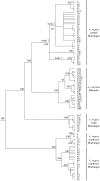The relative importance of ecology and geographic isolation for speciation in anoles
- PMID: 18579479
- PMCID: PMC2607314
- DOI: 10.1098/rstb.2008.0077
The relative importance of ecology and geographic isolation for speciation in anoles
Abstract
The biogeographic patterns in sexually reproducing animals in island archipelagos may be interpreted as reflecting the importance of allopatric speciation. However, as the forms are allopatric, their reproductive isolation is largely untestable. A historical perspective integrating geology and molecular phylogeny reveals specific cases where ancient precursor islands coalesce, which allows the application of population genetics to critically test genetic isolation. The Anolis populations on Martinique in the Lesser Antilles are one such case where species-level populations on ancient precursor islands (ca 6-8 Myr BP) have met relatively recently. The distribution of the mtDNA lineages is tightly linked to the precursor island, but the population genetic analysis of microsatellite variation in large samples shows no evidence of restricted genetic exchange between these forms in secondary contact. This tests, and rejects, the hypothesis of simple allopatric speciation in these forms. By contrast, Martinique has pronounced environmental zonation, to which anoles are known to adapt. The population genetic analysis shows restricted genetic exchange across the ecotone between xeric coastal habitat and montane rainforest. This does not indicate full ecological speciation in these forms, but it does suggest the relative importance of the role of ecology in speciation in general.
Figures






References
-
- Abbott R.J, Ritchie M.G, Hollingsworth P.M. Speciation in plants and animals: pattern and process. Phil. Trans. R. Soc. B. 2008;363:2965–2969. doi:10.1098/rstb.2008.0096 - DOI - PMC - PubMed
-
- Andrews R.M, Nichols J.D. Temporal and spatial variation in survival rates of the tropical lizard Anolis limifrons. Oikos. 1990;2:215–221. doi:10.2307/3565942 - DOI
-
- Avise J.C. Harvard University Press; Cambridge, MA: 2000. Phylogeography: the history and formation of species.
-
- Avise J.C. 2nd edn. Sinauer Associates; Sunderland, MA: 2004. Molecular markers, natural history, and evolution.
-
- Barton, N. H. (ed.) 2001 Special issue on speciation. Trends Ecol. Evol 16, 325–413. - PubMed
Publication types
MeSH terms
Substances
Grants and funding
LinkOut - more resources
Full Text Sources
Miscellaneous

